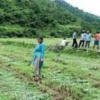Valley of Flowers 2025 Season Ends on October 31 The world-famous Valley of Flowers in Uttarakhand, a UNESCO World Heritage Site, officially closed to visitors on October 31, 2025. Known for its breathtaking alpine meadows and rare flora, the site saw a sharp drop in tourist numbers this year due to untimely snowfall that transformed
Valley of Flowers 2025 Season Ends on October 31
The world-famous Valley of Flowers in Uttarakhand, a UNESCO World Heritage Site, officially closed to visitors on October 31, 2025. Known for its breathtaking alpine meadows and rare flora, the site saw a sharp drop in tourist numbers this year due to untimely snowfall that transformed the valley into a snow-white paradise rather than a blooming floral landscape.
Tourist Numbers Decline Compared to 2024
According to the Uttarakhand Forest Department, the valley welcomed 15,934 visitors (domestic and international) this year, generating ₹3.33 lakh in revenue.
In contrast, 19,401 tourists visited in 2024, contributing ₹3.94 lakh. Officials attribute the decline to unexpected snowfall and changing weather patterns that affected the region’s natural flowering season.
Snow Turns Valley into a Winter Wonderland
Traditionally famous for its colorful blossoms that emerge between June and October, the Valley of Flowers 2025 experienced early snowfall that covered the valley for several days.
While this shortened the blooming season, it also offered a unique snow-clad view of the Himalayas, attracting tourists eager to experience the valley’s winter charm.
Local tour guide Sanjay Sati noted, “Although the flowers had faded early, the snow gave the valley a magical, postcard-perfect look that still drew nature lovers and photographers.”
Forest Range Officer Chetna Kandpal added that around 8–10 tourists continued to trek to the valley daily even after snowfall, proving its everlasting appeal among adventure seekers.
Part of the Nanda Devi Biosphere Reserve
Located in Chamoli district, the Valley of Flowers National Park forms a vital part of the Nanda Devi Biosphere Reserve.
It is home to over 850 species of plants, including many rare and endangered Himalayan flowers.
The park remains open to tourists from June to October, after which it closes due to extreme winter conditions and heavy snow.
Climate Change Impacts on Himalayan Tourism
This year’s early snowfall has raised concerns about climate change and shifting weather cycles in Uttarakhand’s high-altitude regions.
Environmental experts warn that changing climatic patterns may disrupt flowering cycles, affecting both biodiversity and eco-tourism in the future.
Forest officials have confirmed that conservation and maintenance work will be carried out during the winter months to ensure safe reopening in June 2026.
Key Highlights
-
Closing Date: October 31, 2025
-
Total Tourists: 15,934 (down from 19,401 in 2024)
-
Reason for Decline: Early snowfall and weather fluctuations
-
Location: Chamoli district, part of the Nanda Devi Biosphere Reserve
-
Season Duration: June – October
Conclusion
The Valley of Flowers 2025 season ended on a snowy note, replacing its famous floral carpets with white-covered peaks.
Despite the decline in visitors, the valley’s serene beauty and ecological richness continue to make it one of India’s most loved trekking destinations.
As preparations begin for the next season, visitors can look forward to another spellbinding chapter in the heart of the Himalayas.















Leave a Comment
Your email address will not be published. Required fields are marked with *